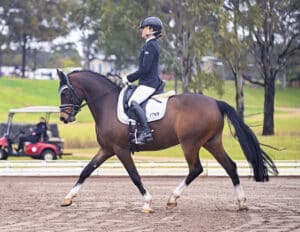The Training Scale guides dressage judges from Preliminary to Grand Prix. National A Level dressage judge and trainer NICOLE TOUGH explains how the scale works.
In a nutshell, judges look for the elements of the Training Scale in every movement. The Training Scale is to a dressage judge, what a curriculum is to a school teacher; both systems setting goals for what students should learn as they progress through their school life. At the Preliminary dressage and four-year-old phase, judges look for the first three elements of the Training Scale – rhythm, suppleness and contact – in all the movements and transitions.
At the end of Grade 1, children need to pass tests before they’re deemed ready for Grade 2; if not, the teacher will recommend they repeat Grade 1. Likewise, riders should be aiming for a satisfactory score of 60% or higher in the Preliminary level, before deciding their horse is ready for Novice, the next level.
At the Novice level, impulsion, the fourth element of the Training Scale is now a requirement to achieve the lengthened trot and canter that is introduced at this level.
Moving up to Elementary, and it’s expected that all six elements have been developed, the last two being straightness and collection.

Nicole riding five-year-old German Riding Pony Dumbledore at Novice level (Image by Rodneys Photography).
This system of training is our curriculum, and the better we develop these six principles, the higher we should score. The judges will apply these universal principles of training to every test, regardless of the level of competition, from the most basic walk/trot tests right through to Grand Prix. Of course, the judge’s expectations will be different at each level, and that will be reflected in the marks they award.
So, let’s look at these elements in more detail. In every movement at the preliminary level the judge is looking for:
• Rhythm – this is when the horse works in regular timing, and the pattern of footfalls is correct for the pace. The speed of the rhythm (tempo) should not be hurried or too slow, and should be maintained before and after a transition into another pace.
• Suppleness – which is shown when the horse is relaxed, swinging through their back, and equally able to stay on figures to the left and right, as well as being able to travel relatively straight on straight lines.
• Contact – the horse should accept an elastic, consistent contact and be working in a round frame, engaging the muscles of the topline.
Then at Novice level, another element is added:
• Impulsion – requiring the horse’s hindquarters to push towards the centre of gravity thereby creating a more uphill balance.
And then by Elementary level, the judges are looking for all the above, with the addition of:
• Straightness – explained as a uniform bend through the horse’s body on circles, turns and in the newly introduced shoulder-in and travers, as well as the ability of the hind legs to land on the same lines as the front legs through circles, turns and on straight lines.
• Collection – where the horse is balanced sufficiently enough on the hind leg to be able to perform all the movements, figures and transitions required at this level without resistance.
When every step of the Training Scale is evident in a movement, the judge is obliged to award at least a 7. A score of 6 should be awarded where the judge recognises a weakness in the Training Scale; a score of 5 is given to a movement where the judge recognises clear weaknesses; a 4 where there are serious problems in the Training Scale; and 3 or below is given where there is disobedience.

The Training Scale applies throughout all dressage levels from Preliminary to Grand Prix.
What about Medium level dressage and above? At these levels, there are harder ‘tricks’ to perform, but the judges are looking for exactly the same six elements. However, each should be further developed, achieving greater degrees of collection, self-carriage and uphill tendency. And it is this heightened, more finely tuned way of going that should be assessed from Medium to Grand Prix level.
Which is exactly why, if the work at these levels is not up to 65% standard, coaches will say ‘back to basics’. As the great Hubertus Schmidt says, “no matter what level of riding we’re talking about, we are all having the same problems, and all of those problems have the same simple solution: more focus on the basics.”
In addition to demonstrating each step of the scale, judges also require:
a) horses to be free from signs of mental or physical tension, and show no resistance to the rider’s aids – in other words, to be happy athletes; and
b) accurate lines, figures, and transitions; the more precise lines score higher as they show a heightened degree of control and difficulty. A rider on the right lines should score higher than a rider near the right lines.
And a last message to consider: safe riding earns safe marks. A rider can’t be a winner and be scared of losing. It doesn’t work. To get high marks, you have to go for high marks. And that comes down to practise. Practise riding for high marks.
Happy training.
Feature Image: Impulsion is a requirement to achieve the lengthened trot and canter introduced at the Novice level (Image by Rodneys Photography).



